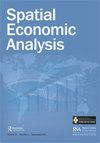提高标准(19)
IF 2.2
3区 经济学
Q2 ECONOMICS
引用次数: 0
摘要
这篇社论总结了发表在第17期(1)(2022)上的论文。这期杂志从第二篇社论开始,呼吁研究人员发表以前研究的复制结果。第一篇论文应用时空贝叶斯层次模型来理解科西嘉岛第二套住房所有权的动态。第二篇论文利用实物期权分析确定了投资新机场的最佳时间。第三篇论文采用单位根检验的方法提供了环境政策变化到目前为止还没有产生效果的实证证据。第四章提供了区域溢出效应在气候变化政策讨论中发挥关键作用的实证证据。第五篇论文预测了到2100年气候变化对农业部门作物产量的直接影响以及对巴西经济其他部门的间接影响。第六篇论文调查了妇女在国家议会中的比例是否对国内和邻国的社会需求公共支出产生积极影响。第七篇论文提出了商店销售评估和预测的总体框架。本文章由计算机程序翻译,如有差异,请以英文原文为准。
Raising the bar (19)
ABSTRACT This editorial summarizes the papers published in issue 17(1) (2022). This issue begins with a second editorial calling on researchers to publish replication results from previous studies. The first paper applies a spatiotemporal Bayesian hierarchical model for understanding the dynamics of second home ownership in Corsica. The second paper determines the optimal time to invest in a new airport using real options analysis. The third paper employs unit root tests to provide empirical evidence that environmental policy changes have not been effective up to now. The fourth paper provides empirical evidence that regional spillover effects should play a crucial role in the policy discussion about climate change. The fifth paper forecasts the direct impact of climate change on crop yields in the agricultural sector and the indirect impacts on other sectors of the Brazilian economy up to 2100. The sixth paper investigates whether the percentage of women in national parliaments positively affects public expenditures on social needs both internally and in neighbouring countries. The seventh paper sets out a general framework for store sales evaluation and prediction.
求助全文
通过发布文献求助,成功后即可免费获取论文全文。
去求助
来源期刊

Spatial Economic Analysis
ECONOMICS-
CiteScore
5.40
自引率
21.70%
发文量
33
期刊介绍:
Spatial Economic Analysis is a pioneering economics journal dedicated to the development of theory and methods in spatial economics, published by two of the world"s leading learned societies in the analysis of spatial economics, the Regional Studies Association and the British and Irish Section of the Regional Science Association International. A spatial perspective has become increasingly relevant to our understanding of economic phenomena, both on the global scale and at the scale of cities and regions. The growth in international trade, the opening up of emerging markets, the restructuring of the world economy along regional lines, and overall strategic and political significance of globalization, have re-emphasised the importance of geographical analysis.
 求助内容:
求助内容: 应助结果提醒方式:
应助结果提醒方式:


